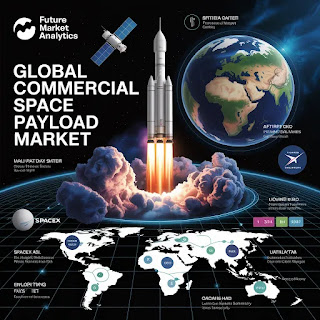The Commercial Space Payload Market: Navigating the Final Frontier of Business Opportunity
The commercial
space payload market has emerged as one of the most dynamic sectors in the
aerospace industry, representing a fundamental shift from government-dominated
space exploration to private enterprise-driven innovation. This rapidly
expanding market encompasses the deployment of satellites and other
technological equipment into various Earth orbits, primarily serving
telecommunications, Earth observation, scientific research, and emerging
commercial applications.
Explore the full report - https://futuremarketanalytics.com/report/commercial-space-payload-market/
Market Size and Growth Trajectory
The global commercial space payload market demonstrates
impressive growth potential, with valuations reaching approximately $32.70
billion in 2021 and projected to expand to between $52-54 billion by 2030,
representing a compound annual growth rate (CAGR) of approximately 5.45-5.6%.
This steady growth reflects the increasing commercialization of space
activities and the growing demand for satellite-based services across multiple
industries.
The satellite payloads segment specifically shows even more
robust growth, valued at $8.95 billion in 2024 and expected to expand at a CAGR
of 15.0% through 2030. This acceleration indicates the market's evolution
toward more sophisticated and specialized payload technologies.
Key Market Drivers
Several factors contribute to the commercial space payload
market's expansion. The proliferation of small satellites, or CubeSats, has
democratized access to space by reducing launch costs and development
timelines. These miniaturized platforms enable startups and smaller companies
to participate in space commerce, creating new market segments and
applications.
The increasing demand for global connectivity drives
significant investment in communication satellites, while climate monitoring
and Earth observation requirements fuel growth in remote sensing payloads.
Additionally, the rise of mega-constellations for broadband internet services,
led by companies like SpaceX's Starlink, has created unprecedented demand for
standardized, cost-effective payload solutions.
Orbital Preferences and Technical Considerations
The commercial space payload market generates revenue
primarily through satellite deployment into Low Earth Orbit (LEO) and
Geosynchronous Earth Orbit (GEO). LEO has gained particular prominence due to
lower launch costs, reduced latency for communication applications, and the
ability to deploy satellite constellations for global coverage.
The shift toward LEO deployments has also influenced payload
design requirements, emphasizing miniaturization, power efficiency, and
radiation hardening capabilities. These technical demands have spurred
innovation in component manufacturing and system integration, creating
opportunities for specialized suppliers throughout the value chain.
Market Challenges and Opportunities
Despite robust growth projections, the commercial space
payload market faces several challenges. Space debris management, regulatory
compliance across multiple jurisdictions, and the need for sustainable space
practices present ongoing concerns. Launch capacity limitations and the high
costs associated with space-qualified components continue to constrain market
accessibility for some applications.
However, these challenges also create opportunities for
innovation. Companies developing debris mitigation technologies, standardized
payload interfaces, and more efficient manufacturing processes are positioned
to capture significant market share. The emergence of in-space servicing and
manufacturing capabilities could further transform the market landscape.
Future Outlook
The commercial space payload market stands at the threshold
of exponential growth, driven by technological advancement, cost reduction, and
expanding applications. As space becomes increasingly accessible to commercial
entities, we can expect continued diversification of payload types and mission
profiles.
The integration of artificial intelligence, advanced
materials, and modular design principles will likely define the next generation
of space payloads. Companies that successfully navigate the technical,
regulatory, and financial complexities of this market will find themselves at
the forefront of humanity's expanding presence in space, contributing to a new
era of space-based commerce and innovation.




Comments
Post a Comment